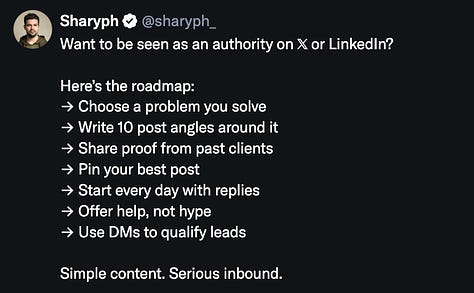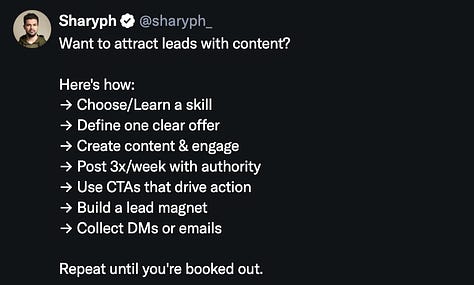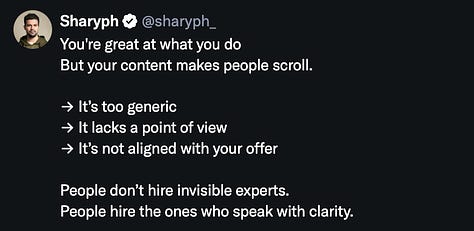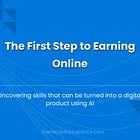In Week 1, we kicked off this roadmap with a bold, but necessary first step:
Uncovering your hidden skills and turning your experience into leverage.
You took the time to explore your own journey, the problems you've solved, the skills you've mastered (often without realizing it), and the patterns that show up in your day-to-day wins.
With the help of AI, you began organizing those skills into clear value buckets.
Now it’s time to take the next critical step in this transformation:
Getting crystal clear on who you’re building for.
This might sound obvious.
But it’s the single biggest reason people waste time creating content no one reads, building products no one buys, and chasing growth that never turns into income.
I’ve seen it repeatedly:
Great creators stay stuck not because they lack skill, but because they’re unclear on who their message is really for.
Let me be blunt: your product idea doesn’t matter if you don’t know your audience.
Your offer can be brilliant, but if you’re talking to the wrong people, it’s invisible.
When I shifted my focus to help creators and entrepreneurs use AI to create, sell, and scale faster, everything changed:
My Twitter threads got higher engagement
My newsletter subscribers skyrocketed
And most importantly, my digital products started converting consistently
Why?
Because I stopped trying to reach everyone and started speaking directly to someone.
A real person, with a real pain, looking for a real solution.
And this week, I’ll help you do the same.
By the end of this lesson, you’ll know:
Who your best-fit audience really is
What makes an audience profitable (and what to avoid)
How to use AI to validate and refine your audience
And how to take action immediately with zero guesswork
Whether you're building your first product or trying to turn your content into income, getting this right will simplify everything.
Let’s dive in.
Why Audience Clarity Comes Before Content, Product, or Growth
Let me tell you something that most creators learn too late:
Audience clarity isn’t just a “nice to have.”
It’s the foundation that decides whether your content gets attention, your product gets sales, or your efforts get ignored.
Here’s what I’ve learned after:
Growing to 75K+ followers on X by writing content people actually cared about
Scaling a newsletter to 18K+ subscribers with no paid ads
Selling 700+ copies of a digital product with $0 in ad spend
All of that was possible because I had one thing figured out early on:
👉 Who I was helping — and why they needed it.
Most creators start backwards
They start with:
A content idea
A digital product
Or worse, a tool or platform they want to use
Then they go looking for someone to sell it to.
But that’s how you end up with
Threads that get likes but no follows
Products that get clicks but no sales
Followers who enjoy your content but don’t buy from you
I've made this mistake myself. I once created a Notion dashboard that I thought was helpful. I spent days designing it, polished the sales page, launched it… and nothing.
Why?
Because I didn’t build it for a specific person with a specific pain.
I built it for myself — and hoped it would resonate with someone else.
Lesson learned: You don’t create for “everyone.” You create for one person with one clear need.
What happens after you get clear on your audience:
When you identify the right person, three things click into place:
1. Your content writes itself.
You know exactly what to say because you know what your audience is already struggling with.
You’re no longer guessing what topic to write today. You know what keeps your audience up at night.
2. Your product becomes a “must-have.”
You're not trying to be creative for creativity's sake. You're solving an actual pain that your audience is actively trying to fix.
You don’t have to convince them to buy. They already want a solution — and you just show them yours.
3. You stop chasing engagement and start building momentum.
Every tweet, newsletter, or product compounds in the same direction — because it’s all aligned to the same person.
Authority tip: The Creator Flywheel Starts Here
People often ask me, “Sharyph, how do you keep creating so much valuable content consistently?”
Here’s the honest answer: I don’t.
My audience does it for me.
Once I got clear on who I’m helping — content ideas, product angles, marketing copy — it all started flowing from what they’re already talking about, asking about, or struggling with.
Let’s be real — vague audiences = vague results
If you’re writing to “creatives” or “freelancers” or “entrepreneurs,” but you can’t name:
What they’re stuck on right now
What result they want in 30 days
What platform or space they live in online
…then you’re not speaking to an audience. You’re speaking into the void.
How AI fits in
This is where AI becomes your cheat code, not for replacing your insight, but for accelerating your clarity.
You can generate detailed audience avatars using prompts
You can analyze communities to extract real pain points
You can reverse-engineer successful creators and see exactly who they’re targeting
In our first issue of this roadmap, we completed the first step. We identified a skill you have, how you can help, or where you are good at. And then we created a skill statement.
Read the full post here. (I suggest complete the actions before reading this post.)
What “Right Audience” Actually Means
(And why getting this wrong kills momentum before it even starts)
Let’s cut through the fluff.
You’ll hear people say, “Find your niche” or “Know your avatar” — but vague advice like that doesn’t help you act.
So let’s define what a right audience actually means — in practical, testable terms.
Related Reading:
The Right Audience Is:
1. A group of people with a shared urgent problem
They’re not “interested” in your topic — they’re actively looking for a fix.
They don’t need convincing. They need clarity.
2. A group with buying intent
They’ve spent money (or plan to) to solve this problem.
They buy tools, books, templates, and courses — not just consume free content.
3. A group you understand deeply
You either are one of them, or you’ve been close enough to know their journey, pain, language, and dreams.
Example from my own path:
I used to get stuck writing content for hours. Once I discovered how to use AI to break down ideas, write faster, and create better — I knew I could help others stuck in the same loop.
I wasn’t guessing. I was the audience.
4. A group you can reach easily
They hang out on platforms you use. They’re part of visible communities.
If you can’t find them online, they don’t count as an audience yet.
For me, this meant staying focused on Twitter/X, LinkedIn and Substack — because that’s where creators and solo entrepreneurs actively discuss pain points around content, marketing, and monetization.
The Wrong Audience Looks Like:
“Ambitious people”
“Anyone trying to grow online”
“People who want to be productive”
“Small business owners”
These aren’t audiences. They’re vague categories.
You can’t market to them, and you definitely can’t sell to them — because you can’t serve them clearly.
Quick Litmus Test: Is This the Right Audience?
Ask these 5 questions:
Do they have a problem urgent enough to pay to fix?
Do I understand this problem from real experience or deep proximity?
Can I find them easily and observe how they talk about their pain?
Do I know exactly what outcome they’re hoping to get?
Can I describe them in one sentence, without using vague labels?
Example:
“Early-stage creators who want to turn their writing into income but struggle to stay consistent and get noticed.”
✅ Real problem
✅ Specific person
✅ Clear goal
Authority Insight: Why Most Creators Plateau
Most creators who plateau are good at creating but bad at defining who they’re creating for.
That was me in the early days.
I’d write solid, useful threads…but they didn’t stick.
Because I wasn’t anchoring them to a real person’s pain.
Once I narrowed my audience to creators who want to use AI to scale without losing authenticity, everything clicked.
More engagement
More shares
More sales
And no burnout, because I knew who I was showing up for.
If you're reading this via email, you might miss part of the content—it's a long one! I recommend checking out the web version for the full experience.
The 3 Core Traits of a Great Audience to Serve
This is how you avoid building for the wrong audience…
Before you go any deeper into content creation or product building, you need to ask one thing:
“Is this audience actually worth serving?”
Not all audiences are equal. Some are enthusiastic but broke. Others are curious but passive. Some are impossible to reach.
And if you choose wrong, your growth will feel like a grind, no matter how good your content or product is.
After years of experimenting (and failing with the wrong ones), I’ve narrowed it down to 3 core traits every great audience must have.
Let’s break it down.
Trait 1: They Are in Motion
The best audiences are already taking steps toward a goal.
They’re not idle. They’re searching, posting, engaging, or spending to solve a real problem.
They’re not asking “Should I start?”
They’re asking “How do I get there faster, better, cheaper, or with less stress?”
Why this matters:
You’re not trying to convince them to care — they already do.
This is the difference between content that gets ignored and content that hits like a lifeline.
From my journey:
When I began helping creators use AI to scale their content, I didn’t target “curious observers.”
I focused on those already creating — just frustrated with how slow and inconsistent it felt.
Trait 2: They Are Underserved (or Misunderstood)
A great audience has pain points that aren’t being addressed well by the market.
Either the advice is too generic, outdated, or doesn’t match how they work.
This is your opportunity to step in with a clearer, simpler, or smarter solution.
Why this matters:
If your audience already has 100 creators shouting at them with the same recycled advice, you’ll drown.
But if they’re underserved, your content will stand out immediately.
What I did:
I noticed that most content about AI for creators was tool-demos or surface-level tutorials.
Nobody was talking about how to actually use AI to build a brand, write better, or monetize faster.
So I claimed that space.
Trait 3: They Are Willing to Invest
This one’s non-negotiable.
If they won’t spend time or money to solve their problem, they aren’t a real audience, they’re just lurkers.
You want people who invest in:
Courses
Coaching
Tools
Templates
Communities
Why this matters:
You’re not just building an audience for likes. You’re building a system that can eventually monetize with integrity.
You don’t need a million followers.
You need a few thousand people with clear pain and real intent.
What I’ve seen:
When I built my X (Twitter) Growth course that sold 700+ copies, I didn’t market it to “everyone.”
I marketed it to creators already trying to grow on Twitter/X — who wanted to do it smarter and faster.
They were already investing in tools, templates, and guides.
Mine just helped them connect the dots.
Bonus Filter: Are You Excited to Serve Them?
This is often ignored.
You’ll be creating content for them, replying to DMs, researching their pains, and building offers around their lives.
If you don’t genuinely respect or enjoy helping them — you’ll burn out fast.
When I began helping AI-curious creators, it never felt like work.
I was one of them.
I knew the frustrations.
I understood the goals. I enjoyed sharing what I learned.
If you get 3/3, you’ve got a powerful audience to build for.
If it’s 1/3 or 2/3, you’ll struggle to grow, connect, or monetize.
Using AI to Define and Validate Your Audience
This is how I shortcut guesswork and find real signal…
I don’t rely on assumptions.
I use AI to accelerate what used to take weeks of research and guesswork down to minutes.
Here’s exactly how to use AI to define, map, and validate the audience.
By the end of this AI workflow, you will:
Understand how you can position yourself (Your Strategic Edge)
Your target audience’s pains, desires and obstacles
3 clear audience personas
7 content pieces…
I was really shocked when I finished this process. And this is what AI with Data tells me I should post on social media. (based on my sample inputs)
Not only this, I also asked to provide me with 7 tweets as a draft. Here is 3 tweets among those. (I didn’t touch this…no edits.)



So, let’s get started.
Step 1: Feed the AI What You Already Know
Don’t start with “Who’s my audience?”
Start with what you’ve already done or already observed.
Prompt:








